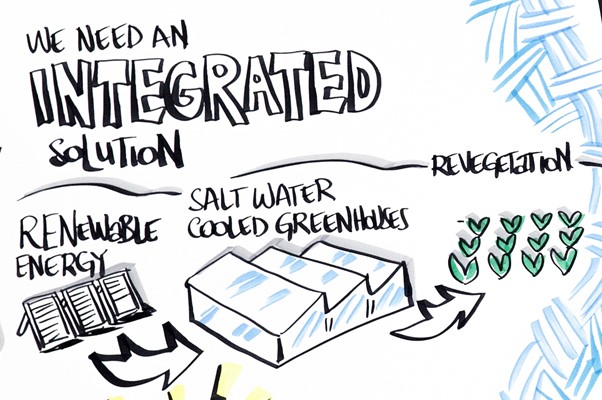Innovations in desert and drylands farming

The global demand for food, water and energy is expected to increase by about 40 to 50 percent by 2030.
This is driven in part by an expanding population, rapid urbanization, greater prosperity and changing diets.
Meeting the increasing demand requires smarter, greener and more efficient food systems – especially as the climate changes and natural resources become scarcer.
“Doubling food production by 2030 will not come from putting more fertile land into production but mainly from sustainably intensifying production – that is, getting more from agricultural lands already in use – and from using marginal lands, such as drylands,” said Alessandro Flammini, an FAO natural resources officer.
The FAO Investment Days, which this year focused on innovations in agriculture, showcased technologies and practices for restoring degraded lands and growing food in the desert.
Regenerating landscapes
One key programme is the Great Green Wall for the Sahara and the Sahel Initiative.
Launched a decade ago, this initiative brings together more than 20 African dryland countries around the Sahara, as well as international organizations, including FAO, the European Union, research institutes, civil society and grassroots organizations to combat the impact of climate change and desertification.
“The aim is to breathe new life into degraded landscapes through sustainable land management agroforestry practices and large-scale restoration. This helps create jobs, stem the distress migration of unemployed youth, improve food security and build communities’ resilience to climate change,” said Nora Berrahmouni, an FAO forestry officer for drylands and the focal point for the Great Green Wall.
“As part of this initiative, FAO is working on a project with local partners and communities in Niger, Burkina Faso and other countries to restore land productivity,” she added. “It is putting communities at the heart of the restoration and using sound land preparation and water harvesting techniques and technologies, as well as seeds and seedlings of native trees, shrubs and fodder grasses.”
Another such innovation, supported by World Vision Australia, is the farmer-managed natural regeneration programme (FMNR), a low-cost, rapid and scalable technique that transforms barren or badly degraded lands into more fertile, productive ground through managed natural regeneration.
It was first developed and introduced in Niger – a country where desertification and drought have undermined food security and livelihood opportunities.
Over three decades, the technique has generated 280 million new trees on 7 million hectares of farmland in the country.
Annual cereal production has increased, the quality of the soil has improved and more animal fodder and firewood, which can be sold for income, are available. Around 2.5 million people in Niger alone have benefited (FMNR video). FMNR practice is spreading rapidly through Africa and has been introduced into some Asian countries.
Desert farming
Growing food in the desert is a reality. The Sahara Forest Project is an innovative scheme using natural resources that are abundant in hot, arid climates – saltwater and sun – to produce food.
The integrated approach combines technologies to generate electricity from concentrated solar power, desalinate water for irrigation and operate salt-water-cooled greenhouses for growing cucumbers and other high-value vegetable crops.
Automated water recovery is used to revegetate and improve the soil conditions of the surrounding lands. The system enables crops to be grown year-round, produces sizeable yields and halves water use.
Responsible investing
Making sure investments in climate-smart technologies are responsible, sustainable and make sense is vital. This is the driving force behind FAO’s efforts to promote Responsible Investments in Agriculture and Food Systems (RAI).
The efficient use of one natural resource can unintentionally lead to the inefficient use of another.

Many farmers across the globe, for example, are turning to solar-powered pumps to irrigate their crops. This cuts production costs and lowers greenhouse gas emissions.
But solar-powered irrigation could lead to the overexploitation of groundwater resources if not managed properly.
One way to ensure investments are responsible and sustainable is to look at them through the food-water-energy nexus, assessing trade-offs and unintended consequences.
“The nexus approach makes you look at the wider picture – water, energy, food, capital and employment,” Flammini said. “With an investment in irrigation, for example, you would assess its impact on energy consumption, the water table, the efficient use of capital, job creation and wages.”
Policy dialogue
There is a wealth of innovative climate-smart technologies available in the private sector, and the industry continues to grow. FAO can play an important role in promoting awareness and policy dialogue around such new technologies.
“When I go to countries, I often see a gap between the information that reaches the policy-makers and the amazing things that practitioners are doing in the field,” Flammini said. “One of the roles FAO can play is to facilitate information exchange among policy-makers on new technologies and innovations from the private sector and academia to bridge that knowledge gap.”
This is one in a series of articles aimed at sharing the latest thinking and learning on innovations in agriculture from FAO Investment Days 2017.
